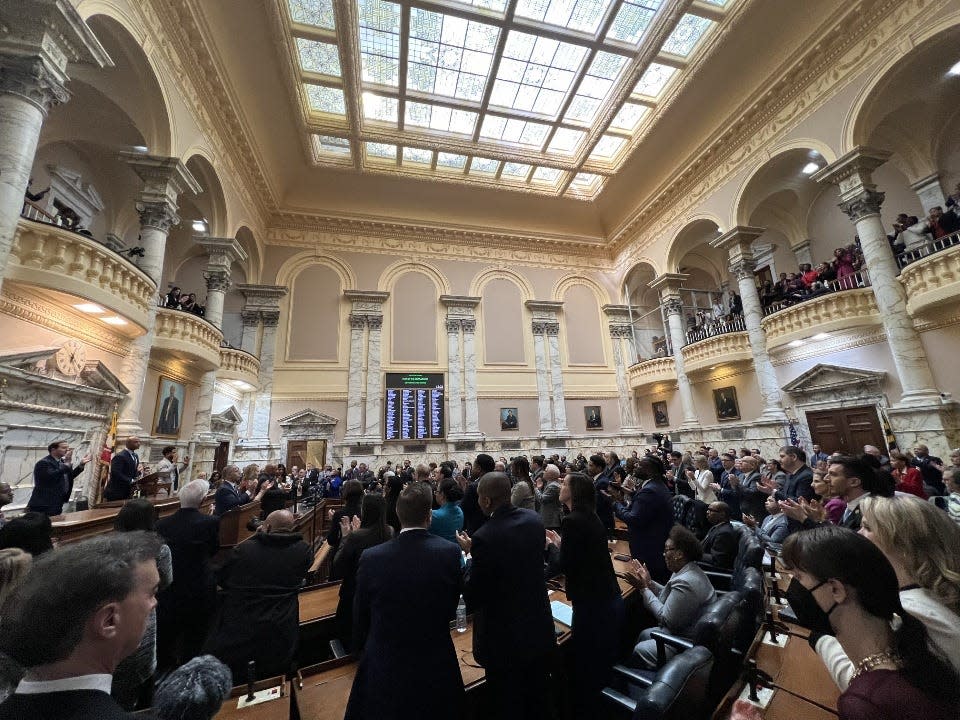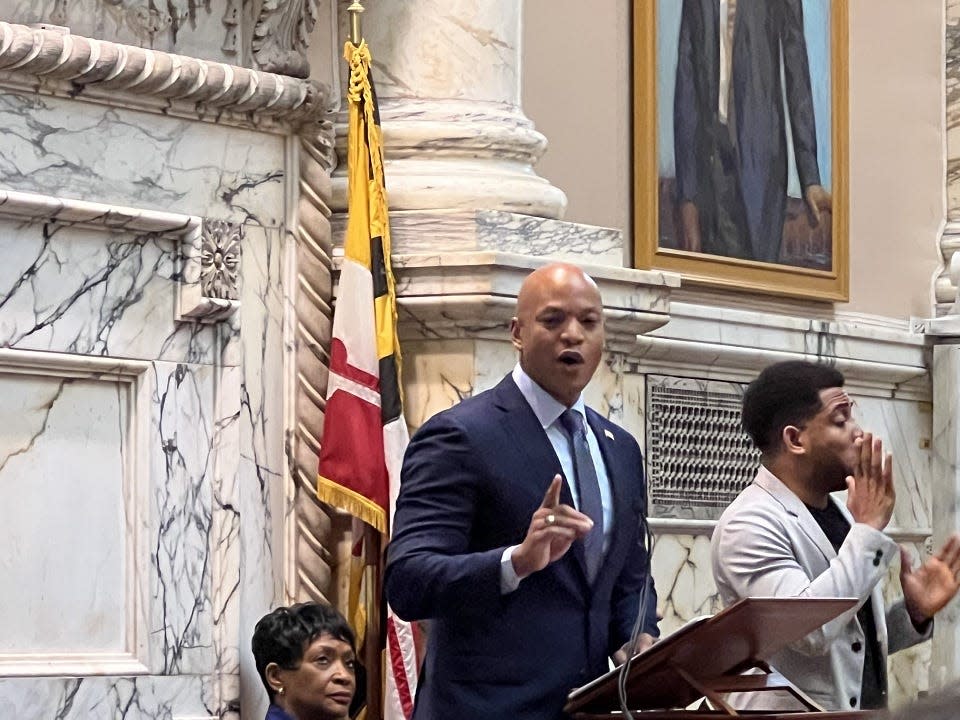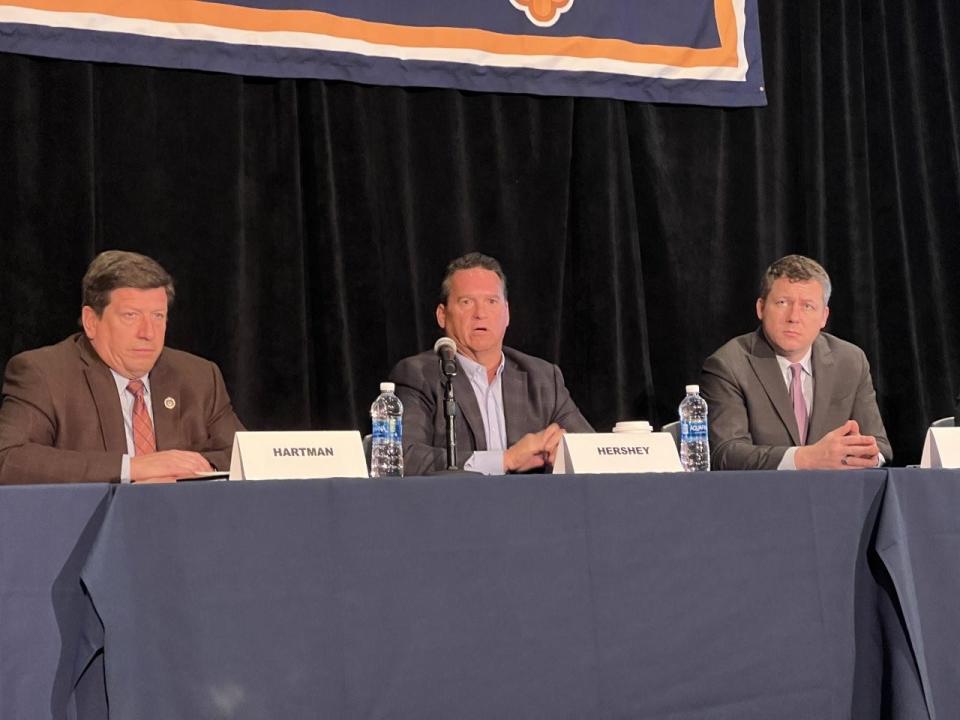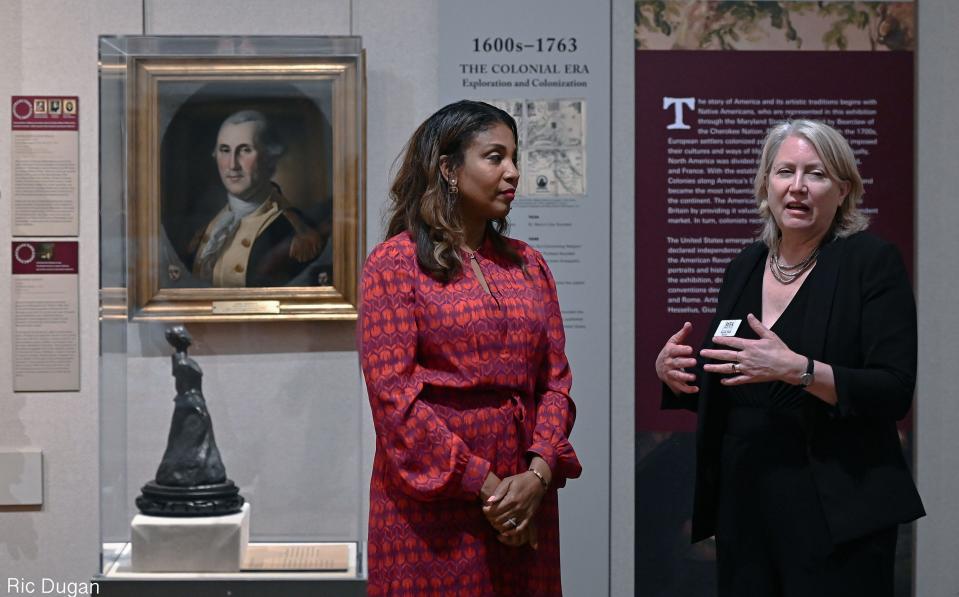'The state of our state is strong': Gov. Moore delivers second State of the State address
- Oops!Something went wrong.Please try again later.
- Oops!Something went wrong.Please try again later.
Maryland Gov. Wes Moore delivered his second State of the State address in front of a packed House of Delegates chamber on Wednesday, emphasizing the state’s strength while laying out his policy objectives in the areas of public safety, affordability, competitiveness and service.
“A change is happening,” Moore, a Democrat nearing his 13th month in office, told a joint session of the Maryland General Assembly, “and today, the state of our state is strong.”
It was one of many applause lines in the state’s chief executive’s speech that lasted about an hour. County executives from Anne Arundel, Baltimore, Frederick, Harford, Howard, Montgomery, Prince George’s and as far away as Wicomico County were on hand, as was the mayor of Baltimore. Republican state senators sat behind the collection of county executives representing both parties in an area typically reserved for press, while members of the media lined the chamber’s wall.

Cabinet secretaries sat in chairs on the House floor while Maryland Attorney General Anthony Brown, Comptroller Brooke Lierman, Treasurer Dereck Davis and Lt. Gov. Aruna Miller sat beneath the speaker’s rostrum where the state’s first Black governor delivered his remarks. There appeared to be an increased security presence around the State House, with state trooper vehicles on the Annapolis streets.
Exemplifying what can be missed during the speech’s pomp and circumstance at the crowded historic State House, state Sen. Brian Feldman, D-Montgomery, the chair of an important committee, had no seat. The veteran lawmaker stood next to members’ desks for the duration.
Public safety a priority for both Moore and Republican leader
After previewing that the administration is going to release a “state plan” this week to chart the course for the next three years, Moore said the plan is a reflection of the people’s aspirations.
He cited his visits to the state’s Eastern Shore, including driving farmers tractors, and to Western Maryland’s Washington County, where he grieved the assassination of a Maryland judge.
More: After attack on Maryland judge, bill brought to protect judiciary members, their families
In an interview outside the House chamber after the governor’s remarks, Del. Sheree Sample-Hughes, D-Wicomico/Dorchester, said she found the speech “comprehensive.”
“He went out, boots on the ground, talking to citizens,” said Sample-Hughes, “that really brought hope for me as a legislator to know the pieces of legislation that we’re hearing and that he has introduced in this session is really important directly to the people of the state of Maryland.”
One of those pieces of legislation Sample-Hughes cited is the Growing Apprenticeships and the Public Safety Workforce bill, or GAPS Act. The legislation aims to reduce vacancies in law enforcement through apprenticeships. The Eastern Shore state delegate compared the effort to the military’s Reserve Officers’ Training Corps (ROTC) programs.
More: 'Recruitment’s the most difficult thing': How police undertake it in new environment
The second-year governor urged those in the chamber to move beyond “the simplicity of how pundits talk about public safety, and move toward the complexity of how people experience public safety.”

“The sound of a police siren does have a different pitch depending on what neighborhood you grow up in,” said Moore, referencing his own experience handcuffed by police as an 11-year old.
More: Non-fatal shootings double in Maryland in 8-year stretch. Funding to help on the way.
Sample-Hughes, who is Black and whose son is in law enforcement, called Moore’s statement that people shouldn’t have to choose between feeling safe in their skin and feeling safe in their communities “pretty impactful.”
The governor, in his address, said public safety remains a “top priority.” It was also the top priority cited by state Sen. Steve Hershey, R-Caroline/Cecil/Kent and Queen Anne’s, in his Republican perspective on the State of the State aired after Moore’s remarks.
“While we share Gov. Moore’s desire to transcend partisan divisions and work together for the betterment of Maryland,” said Senate Minority Leader Hershey, in his prepared remarks, “it is imperative that we also present alternative solutions and ideas.”
Moore notes state’s high eviction filing rate, housing bills
Moore noted his administration’s efforts to make the state more affordable, referencing an introduced housing legislation package and the state’s “single largest investment” in childcare.
He also directed attention to some of the state's problems.
More: Maryland Housing Secretary Day estimates 96,000-unit housing shortage. Bills aim to help.
More: Moore's Maryland budget boosts child care, education, without raising taxes. What to know.
“Maryland has the highest eviction filing rate in America,” Moore said. More than 400,000 “failure to pay rent” cases were filed in the state’s 2023 fiscal year.
Referencing the legislative housing package, he said: “We will work together to get it done.”
Challenges abound for state and Maryland’s governor
Even in a state capitol where both chambers are dominated by Democratic members, the challenges of governing confronted by Moore, now the politician who lives across the street in the Government House, also known as the Governor’s Mansion, are manifold.
In the post-address interview, Sample-Hughes, also a Democrat, highlighted the governor’s statement that $1.4 billion went to small business and minority business through the state’s Board of Public Works. Unsaid in the governor’s address is that minority business enterprise participation rose only slightly (to 17.85%) during the administration’s first six months and Maryland fell short of its aspirational goal of 29% yet again. The state has missed that mark in administrations of both parties.
Moore said the administration provided “over 130,000 laptops to underserved households to narrow the digital divide.” Unsaid is, despite the efforts of legislators to expand broadband access and the governor’s own efforts to increase internet affordability, in some parts of the state (i.e. Somerset County) reliable broadband was not yet a reality for all during Moore’s first year.
The governor cited the administration’s efforts toward clean energy, but challenges remain in bringing the state together to achieve those goals, especially with offshore wind and solar energy.
He promised a robust debate on how Maryland funds transportation projects. The state faces a multi-billion-dollar transportation shortfall, according to departmental plans released last year.
More: Transportation top issue as Washington County comes to capital for 'Day in Annapolis'
Pledging also to strive for the best schools in the entire country, Moore said achieving that goal is not an issue of money alone, but also one of strategy, accountability and partnership with local leaders.
The Senate Minority Leader, who mentioned the state’s education law in his prepared remarks, said: “The results we are seeing do not seem to align with the level of investment.”

“We must be disciplined in prioritizing the programs that are cost-effectively achieving their intended results while eliminating or scaling back the ones that are no longer necessary,” said Hershey, of state programs generally.
More: After Maryland's community college enrollment grows, state funding shrinks. Find out why.
Maryland’s chief executive, who used to lead the nation’s largest anti-poverty organization, pointed to the ENOUGH Act, a bill introduced this year designed to address child poverty. At the same time, poverty rates in the United States have been stubbornly consistent over the last five decades.
‘This will be Maryland’s decade,’ Gov. Moore says
Yet, the change brought by the Moore-Miller administration over the past year was present not just near the Speaker of the House’s rostrum, but in the House gallery as well. A young man from Western Maryland in the inaugural Maryland Service Year Option program stood to applause, wearing the uniform of the state’s community service program for 18–21-year-olds.
In keeping with the theme of service, Moore announced 2024 as the “year for military families in Maryland.” In doing so, he did a rare thing for many a politician: acknowledging a past mistake.
Moore, a former combat veteran, said that when he deployed to Afghanistan he thought deployment was toughest on the soldiers. “I was wrong,” said the governor, with his now wife, the state’s First Lady Dawn Moore, in the gallery.

The state’s First Lady, Lt. Gov. Aruna Miller, along with the secretary of Veterans Affairs are set to lead that initiative for military families this year, Moore said.
“This will be Maryland’s decade,” said Moore, in closing, “not because we say so, but because we make it so — together.”
In an interview afterwards, Sample-Hughes said the governor’s remarks were an “all-inclusive speech,” adding “I found it quite hopeful.”
Dwight A. Weingarten is an investigative reporter, covering the Maryland State House and state issues. He can be reached at dweingarten@gannett.com or on Twitter at @DwightWeingart2.
This article originally appeared on Salisbury Daily Times: Gov. Moore previews plan for Maryland in State of the State address

